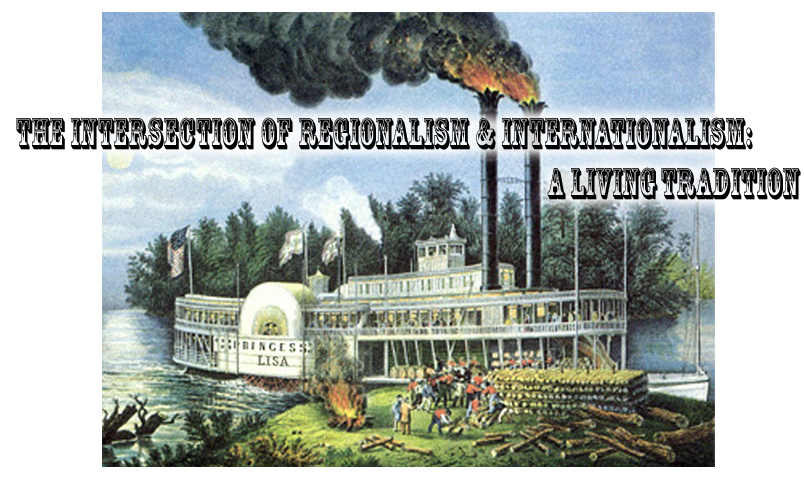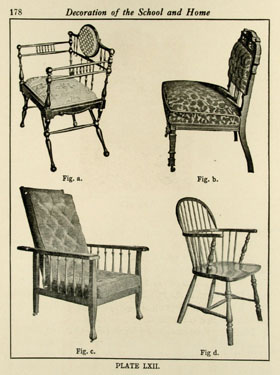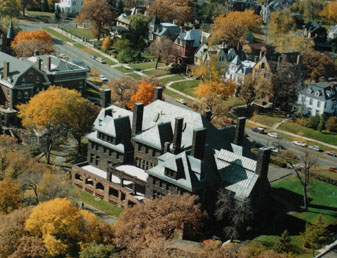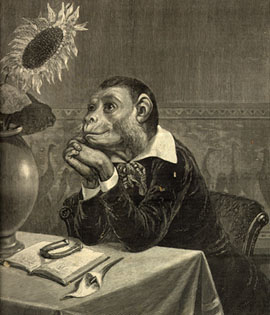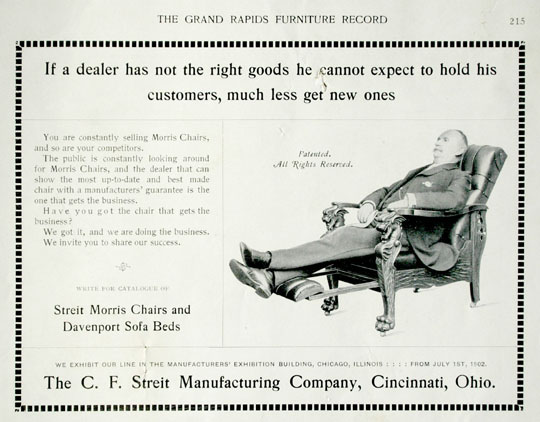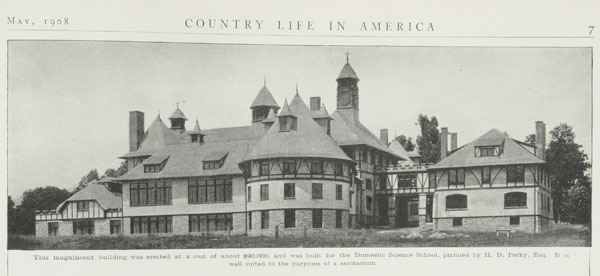|
|
Lisa Koenigsberg’s traveling Arts and Crafts conferences used to be held under the auspices of New York University and have been major meet and greets for mission mavens since 1999. Now they are a part of an independent organization called Initiatives in Arts & Culture. From the start, Koenigsberg has relied on what she calls her “family” of lecturers—they make for a kind of road show or repertory theatre very much like Show Boat. Instead of Gaylord Ravenal, Ellie May Chipley, Frank Schultz, and Parthy Ann Hawkes, we have Richard Guy Wilson, Cheryl Robertson Schloerb, W. Scott Braznell, and Koenigsberg. This year in Minneapolis we even had Old Man River! The problem is that the cast has been playing the same roles (architecture, Prairie School, metals, and martial arts, respectively) since the 1970s, so they just slightly alter the lines of a tattered thirty-year-old script to fit each new venue. As a result, conference attendees learned precious little about aspects of “regionalism” or “internationalism” unique to Minnesota.
|
| John Scott Bradstreet, though hardly a “living tradition,” is all about internationalism. However, despite her thesis about Bradstreet’s attempt to create a vernacular style, sexy Sarah Sik (Magnolia Hawkes?) failed to prove he was anything other than an anomaly in the rough-and-tumble Minneapolis of the 1890s. It would be nice if somebody sometime brought aesthetics into the act—but it isn’t going to be Sik. By talking about things like “vernacular,” “cohesive agenda,” and that worn-out shtick “progressive” and not talking about Art Nouveau or Bradstreet’s atrocious revival stuff, Sik gives us the same old Arts and Crafts song and dance. She even casts his contrived jin-di-sugi method of distressing wood as “truth to materials.” I love Bradstreet’s work primarily because so much of it is sublimely ugly. Sik, who gave virtually the same talk at Koenigsberg’s Japonisme conference a couple of years ago, never shows the grotesque dolphin-armed settee now at the Met or the pig table from the Donaldson House. No one seems to notice that the 1890s Moorification of the 1860s Italianate Craftshouse is as inept as the 1850s Gothic update of an 1820s Federal-style house in Kennebunk, Maine called the “Wedding Cake House.” |
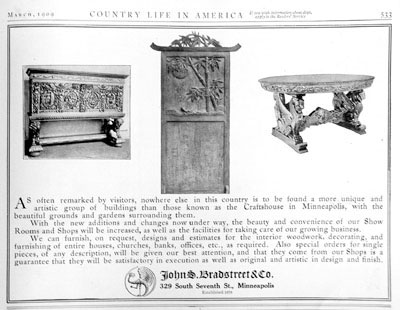
An advertisement from a 1909 magazine shows a chest and table executed in an ersatz Rennaisance style typical of Bradstreet, but ignored by modern scholars because it cannot be excused as progressive.
|
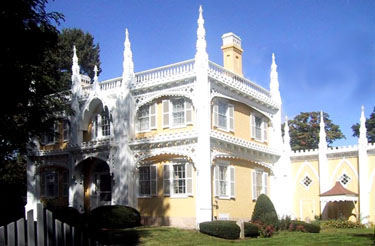
“The Wedding Cake House” built in 1825,
Gothic decorations added circa 1852.
|
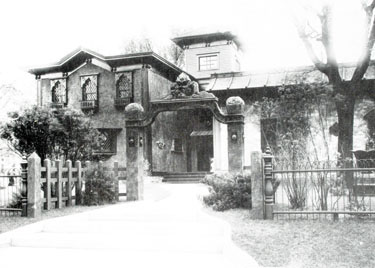
John Scott Bradstreet’s Minneapolis Craftshouse,
Original Italinate house circa 1860, modified by Bradstreet starting in 1904
|
|
Sik’s mentor is Gabriel Weisberg (“Gabe” to members of Koenigsberg’s family). Weisberg’s lively, not to say passionate, presentation was, for me, the cornerstone of the symposium. He had the balls to connect Arts and Crafts to Art Nouveau and consumerism. Recent Arts and Crafts extravaganzas such as “International Arts and Crafts” from the Victoria and Albert Museum avoided that connection, even though their earlier “Art Nouveau: 1890–1914” included William Morris, Frank Lloyd Wright, Charles Rohlfs, and William Gates but, inexplicably, not Bradstreet. American scholars hold all of these designers to be sacrosanct parts of the holy experiment that was the Arts and Crafts movement.
Perhaps more controversial is Weisberg’s notion that lucre had something to do with the way Arts and Craftsmen improved Everyman’s life with beauty—yes, I said “Everyman” because the word stands for the exact concept I wish to evoke. I am not going to bow to a politically correct dilution of language that requires “Everywoman” to be coupled with “Everyman” as another Weisberg student might prefer. If Weisberg ever presented his ideas about consumerism to his classes, Debra Hegstrom was asleep. She’s very angry with poor old Gustav Stickley, who never had a mean or original thought. Had she considered consumerism at all she might have realized that, even if Stickley actually wrote the article she cites, “Ornament: Its Use And Its Abuse” (Craftsman 1905), he was merely swift boating. He did not really equate ornament with degenerative feminization as she does. The drawing of the “bad-taste” chair she showed on the projection screen was a thinly disguised rendering of the product of S. Karpen & Bros., which was a Stickley competitor that also produced a mission or Arts and Crafts-style line of furniture. Male chauvinism or age-old advertising ploy?
|
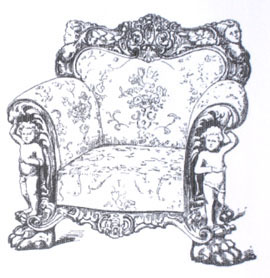
Ornament abused: Craftsman illustration, which is a thinly
disguised copy of a popular Karpen Brothers design.
|
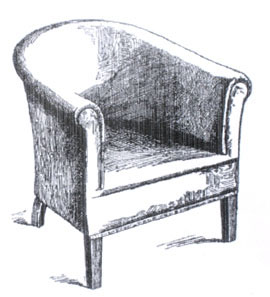
Chaste chair: Although Stickley never made such a comfortable chair,
similar designs started to appear in the 1880s (notably in A. H. Davenport
interiors such as the elaborate 1891 James Hill house) and have continued
to be fashionable into the 21st century
|
|
|
While the Arts and Crafts movement did try to improve middleclass taste, the mission was not limited to Stickley and his fellow travelers. Nor was it gender oriented--a 1916 teachers’ manual is profusely illustrated with photographs of female teachers instructing boys and girls in the fine points of choosing properly plain portieres, pillows, pictures, vases, and lamps. The text accompanying the illustration shown at left points out that “The spindle work and other ‘gimcrack’ ornament which manufacturers put on chairs like fig. a, plate LXII, is as meaningless as it is ugly. The spindles break easily, the chair is disfigured and is unsafe, yet it costs three times as much as the Windsor chair.” The text also denounces the plush-covered chair for being “veritable dust catchers and retaining a great many dangerous germs.” |
| The feminist fire in Hegstrom’s eyes blinds her in many other ways. Importantly, her comparisons ignore economic classes and are off by about two decades. She blithely suggests that elaborate Victorian city houses were intentionally manmade to trap wives at home. She ignores the fact that men who could afford such urban houses also had grand country houses with hundreds, if not thousands, of acres in which wives could be better isolated if that were their husbands’ intent. Had Hegstrom wanted a regional connection, St. Paul’s 1890, 36,000-square-foot James J. Hill House might have served. The Hills also had a country house, North Oaks, set on 5,000 acres. But Mrs. Hill wouldn’t fit Hegstrom’s bill because she had been a workingwoman and, like Mrs. Havermeyer in New York or Mrs. Palmer in Chicago, she was not a woman to be subservient to any man. Hegstrom uses an 1890s “Turkish corner” to illustrate the ornate (read: feminine) interior décor Stickley wished to simplify with macho mission style. While there were Davenport chairs in the Hill House that exactly match the acceptable simple chair in Stickley’s Craftsman article, the chronology is wrong, as is Hegstrom’s interpretation of Stickley’s crusade to simplify. To the extent that The Craftsman had any influence on America’s huge and growing middle class, it would not have been significant until well after 1901 when the first issue appeared. The magazine never appealed to the very rich who had the type of Turkish corners Hegstrom showed. Such décor was pretty much out of fashion by 1905 when The Craftsman (not Stickley personally) was trying to boost product sales. |
|
|
|
|
The vast Hill house in St. Paul had interiors designed by A. H. Davenport, which used many pieces of upholstered furniture (exemplified by the chair at the foot of the stairs to the left of the photograph) that would have fit the aesthetic edicts set forth in “Ornament: Its Use and Abuse.” It is difficult to see how these highly ornamented rooms could be characterized as either degenerate or feminine.
|
|
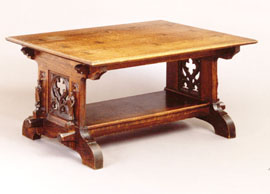
Elaborately carved table designed by Will Price
and made in the Rose Valley Shops
|
Hegstrom argues that Stickley was against a Wilde sort of ornamentation because he was against demoralizing feminization. She says Oscar Wilde’s critics depicted him as effeminate but illustrates her point with period cartoons in which he is compared to a monkey—I’m all mixed up here. Was it a female monkey? Are apes to be equated with women? This is bogus. There were, of course, real gender issues in the Arts and Crafts movement, but Hegstrom and others are not up to delving into a third gender in order to posit credible theories—homosexuality is the ignored (pink) elephant in her room.
But I believe that the type of extreme ornamentation Stickley denounced had no gender. Certainly the monstrous Grand Rapids Morris chairs, with their carved arms of snarling lions waiting to bite the hands that rested on them, were degenerate without being feminine. Many ornate pieces of furniture were poorly constructed, but many other pieces were of the highest quality and some, like those designed by Will Price and made at Rose Valley, represented the loftiest of Arts and Crafts ideals. Ornamentation was a matter of taste and perhaps health, not social engineering. At that time many words were lavished on the idea that simplification promoted hygiene. The housekeeper, be she wife or servant, would have an easier job controlling dirt and germs if the nooks and crannies necessary to fancy, fussy interiors were eliminated. Family health, not female subjugation, was the very progressive intent.
|
|
|
|
A Morris chair with dragon heads almost identical to the one shown in this 1902 trade journal ad is shown in the teachers’ manual as a “monstrous counterfeit (sic) debasement” yet the copy here sounds very like Stickley’s high-minded admonishments by suggesting that the best made chair is the one that “gets the business.” Of course chairs such as the Streit recliner were not well-made yet even today there are many people who do not find its machine-made ornamentation to be an abuse. I cannot understand this as a gender issue--perhaps because I am a male.
|
| Hegstrom goes so far as to suggest that Stickley made a conscious effort to keep women at home by including directions for needlework in The Craftsman, but I heard no actual Stickley quotes to support her notion. Surely publishing needlework instructions in magazines (which happened long before and ever since The Craftsman) has more to do with consumerism than a dastardly desire to control women. She must also believe that Gus was an accomplished blacksmith because the magazine published a photograph of him wearing a leather apron standing next to an anvil in a smithy. I’ve often wondered why William Morris’ wife and women friends tolerated the slavery required to execute his needlework designs. I never thought of it as a gender issue since Morris was willing to knot his own rugs and, after all, his wife was the one who made him a cuckold, not he her. |

William Morris teaching an audience of both men and women how to weave. This charicature was drawn by Edward Burne-Jones, but another artist friend mocked Morris in charicature as well as by bedding Jane Morris.
|
|
|
|
|
|
Needlework instruction for the homemaker before and after Craftsman: an 1868 Godey’s Lady’s Book and a 1996 Martha Stewart Living. Godey’s, Craftsman, and Living had powerful female editors, who were unlikely to countenence the use of needlework as a means of keeping women at home. It is more likely that their intent was to provide the middleclass housewife/homemaker with better-designed household niceties than were available from peddlers. mail order, or department stores.
|
| At the end of her spiel Hegstrom narrowed her eyes and accusingly wondered why this ordinary entrepreneur didn’t have extraordinary, radical ideas. She thinks Stickley was sexist because only young males were allowed to learn farming at his Craftsman Farms. Right or wrong by today’s standards, back then boys and girls were usually separated for education, sports, and restrooms. Stickley must also have been a racist because there was not one black face among all those little white boys. Again there is the queer factor to consider. I’m not suggesting Stickley was gay, but I do think we must consider his muses: Ashbee, Carpenter, Whitman, and Bradstreet, among many lesser gods like Hervey White, all had a thing for helping handsome young men get on in life.
The president of the Natural Food Company, Henry Perky, founded the Oread School and later built Filston Farm. These self-supporting farms were “to be places of domestic science, in which young girls were to be taught the secret of preparing foods in a way so simple that health and vigor and pure blood would drive out all taint of moral or physical weakness. It was [Perky’s] hope that from these institutions would spring a cult which would spread, and eventually all women, for the benefit of posterity would become interested.” Perky died just after Filston was completed in 1908. Had he been able to carry on his cult, Hegstrom would probably fault him for not running coed institutions.
Irene Sargent, Muriel Irwin MacDonald, and Mary Fanton Roberts must be inconvenient truths in Hegstrom’s thesis because she never mentions their power at The Craftsman. Hegstrom clomped triumphantly off the stage to huddle in solidarity with a be-bunned buddy… er, sister.
|
|
One of the many buildings of the Oread School, which was to be a self-sustaining farm where young women were
to be taught domestic science. Country Life in America 1908
|
| Hegstrom and her preceding act would do well to get out of the Craftsman circus tent and look back at it objectively from the Arts and Crafts highway. I’m okay with Eileen Michels’ effort to debunk the current assessment of the role Harvey Ellis played in designing furniture at the Craftsman factory, but she can’t say as she does that “with the publication of The Craftsman, Stickley became the de facto leader of the American Arts and Crafts movement.” Only people obsessed with Gustav Stickley who have not researched the rest of the movement or indeed the rest of art in this country and abroad believe such an unsupported claim. Michels appears to be almost as long in the tooth as I am, so she should remember that dealers like Jordan-Volpe (egged on by New York Times antique (sic) reporter Rita Reif) needed the Ellis mystique in order to establish a price scale. In the 1970s clunky, spartan Stickley stuff like the Eastwood chair did not appeal to flashy customers like Max Palevsky, Richard Gere, and Barbra. They needed seductive curves and inlaid metal ornamentation, however degenerate and feminine. They also craved rarity. Inlaid pieces in apparently good condition certainly were rare only because they were more difficult to tart up than plain oak pieces. The problem was how to account for the different aesthetics of the svelte inlaid designs and the ponderous mission style. Back then the only name other than Stickley that could be connected to the Craftsman enterprise was Harvey Ellis, so his oeuvre was invented, even though some of us thought the inlay was imported or, at very least, not designed by Ellis and not made at the Craftsman factory. We giggled when Beth Cathers began extolling “the Ellis curve that causes visual tension,” and we shuddered when the Jordan-Volpe Gallery (“Theatre of Art” was the way Todd Volpe styled it) published Furniture of the American Arts and Crafts Movement, which featured a photo of inventory set up in their cork-lined gallery on the dust jacket while the text purported to be objective history. |
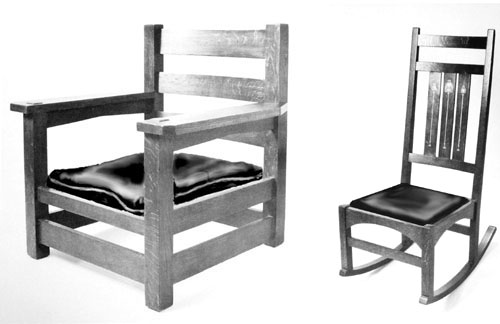 |
Clunky, overbearing designs like the Eastwood chair at left were difficult to incorporate into the museum-like white living spaces favored by rich collectors who had no intention to live the Arts and Crafts simple life in New York City or Los Angeles. The attenuated elements of the “Ellis” inlaid rocker better suited the furniture-as-art-object mentality of moneyed moguls living in the Dakota or at the top of the Sherry Netherland. |
|
| Michels further compromises her credibility by ridiculing an Ellis house design that wasn’t in the standard, pedantic, pedestrian Craftsman mode. Could a student of architecture such as she not know that the elegantly refined, asymmetrical plan was not merely a bizarre aberration? It clearly relates to late nineteenth-century designs by E.W. Godwin, and to modern Austrian architecture. Its Dutch gables would have been meaningful to residents of New Amsterdam even if Michels doesn’t get it. It’s a shame that the Ellis house was never built, but enough houses of the same style were built, including the Dowling House in Rochester, New York and Schoenhaus in Rose Valley, Pennsylvania to take the curse off all those dreary bungalows built by people with no imagination. Come on, Eileen—if I can think beyond Stickley, anyone can. |

A Harvey Ellis design published in a 1903 Craftsman.
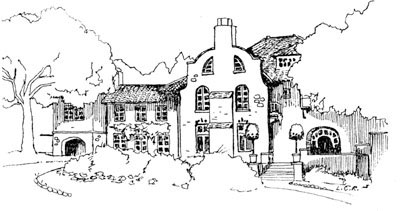
Rose Valley Farms (AKA "Shoenhaus") was designed by Price and McLanahan and built in Rose Valley in 1905.
|

A Craftsman rip-off of Will Price’s “House of the Democrat.” |
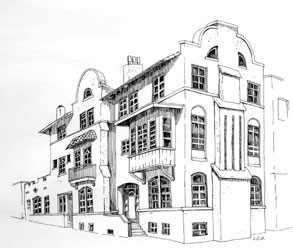
The Dowling house designed in 1909 by Ogden and Van Guysling and built in Albany, New York. The illustration is from TILLER, Volume One, number 1.
|
|
One speaker did make good, creative, and fresh use of the big picture, however. Martin Wachadlo convincingly showed how the work of architect J.L. Silsbee was a significant antecedent to the Prairie School. His kind of imaginative thinking was sorely needed at this symposium. Wachadlo showed a photograph of a young Frank Lloyd Wright looking Wildely effeminate/degenerate in cape and blouse. Speaking of fairies, we also had to endure the fey comments of new family member David Ryan. He was ever so cute…or drunk, and should have let the Norwest Corporation collection speak for itself and himself. His achievement is laudable. His presentation was lamentable.
The symposium would be vastly improved if Koenigsberg went after quality instead of quantity. By the end of each day I was exhausted and didn’t care if I saw or heard one more thing. After a grand reception at the fabulously done up Donaldson House, I was chided because I hadn’t walked across the street to see the Kenyon House. I dutifully went and found a little room crowded with Bradstreet experts—now I know enough about Bradstreet to hold my own, but I simply didn’t have the energy or will to raise the volume of my voice so it could be heard above the screeching doctors. Poor planning on Saturday meant too much time at the National Farmers’ Bank in Owatonna and no time to visit the Lakewood Cemetery as scheduled. That evening ended with a pointless, pathetic reception at architect Stephen Holl’s Rapson Hall. None of us knew what we were doing there, so most of us walked in the rain to Pillsbury Hall, designed in 1889 by none other than Harvey Ellis. Pillsbury Hall and Hill House turned out to be the highlights of my trip. Only a drive-by of the exterior of Hill House was scheduled for Sunday, but I wanted to see what A.H. Davenport furniture remained inside. To do so, I skipped the symposium’s morning tour to Stillwater and the sales rooms of contemporary potter Warren MacKenzie as well as my prepaid box lunch. I was sitting quietly in the Hill’s vast, cool music room waiting for a docent to begin a scheduled tour when what to my wondering eyes should appear but a miniature Koenigsberg and a hundred hot, pee-filled artsandcraftsistas who swarmed past the protesting docents and invaded every corner of the house as if they had a right to disrupt our tour and violate historical society rules.
|

Ralph Rapson Hall designed by Stephen Holl for the University of Minnesota
|
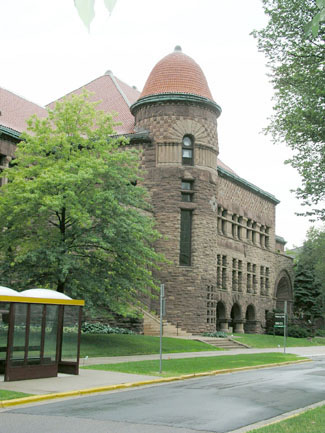
The manly tower on University of Minnesota’s Science Hall
designed in 1889 by Harvey Ellis
|
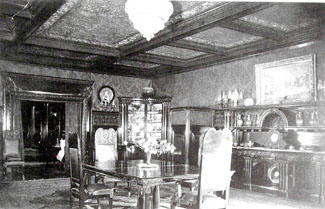
Furnishings by A. H. Davenport in the 1890 James Hill house, St. Paul, Minnesota
|
|
|
| Vetting the presentations might not be popular with those in “the family” who wait until the last minute to arrange their slides, but it would save precious time by eliminating redundancy. Richard Guy Wilson began the first session with “Sullivan on the Prairie: Banks and Influences” by showing Sullivan’s most famous bank; presenters then reviewed the basics about the admittedly iconic National Farmers’ Bank over and over again. Not only did we hear William Gray Purcell’s biography more than once in the lecture hall, we also had to strain to hear the sweet but inaudible gentleman at Redeemer Missionary Baptist Church say it again. The gracious, well-meaning owner of the Backus House had to contend with noise from bus and car engines as he gave his version of the same history. I am mindful of the colossal amount of work involved in producing one of these conferences, but I don’t think such vetting would add significantly to the administrators’ burden and might actually reduce it by taking away the seemingly frantic improvisation and disappointment that happens when the schedule falls apart as it always has. Goodness, with a buffer of time we might even see the return of the long-gone question and answer periods. With so many experts in the audience, questions should be as valuable as the actual presentations. |
|
|
